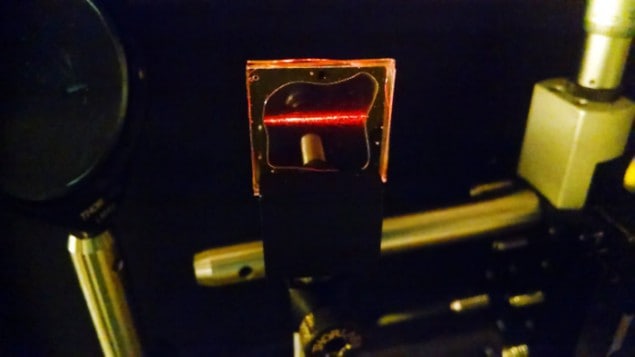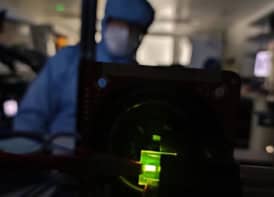
A thin-film material that converts infrared light into visible light has been unveiled by researchers at the Massachusetts Institute of Technology (MIT). Made of two non-conventional semiconductors, the material works for infrared light at moderate intensities, and could be used to improve a range of technologies including solar cells, cameras and night-vision goggles.
The team, led by Vladimir Bulović, Moungi Bawendi and Marc Baldo of the Energy Frontier Research Center for Excitonics at MIT, made its films on top of glass microscope slides. The films have a simple, two-layer structure. The bottom layer consists of colloidal quantum dots. These are nanometre-sized chunks of the semiconductor lead sulphide coated with a molecular layer of fatty acids. The top layer is a crystalline film made of an organic molecule called rubrene.
Colliding excitons
The conversion process begins when a quantum dot absorbs an incoming infrared photon. This energy is then transferred to the neighbouring rubrene film in the form of an electron–hole pair. Called excitons, these pairs diffuse through the rubrene, where they can collide with each other.
“When two low-energy excitons collide, they can create a high-energy exciton, which we call a ‘singlet’ because of the spin physics in these materials,” explains team member Mark Wilson. “The high-energy singlet can emit visible light, so, in short, we are able to change the colour of the light from infrared to the visible,” he adds. Energy is conserved during this upconversion process and the absorption of two lower-energy infrared photons is required to generate each higher-energy photon of visible light.
The upconversion of infrared light at wavelengths greater than about 1 μm had proved difficult in the past because the materials used to absorb the infrared light tended to heat up rather than produce useful excitons. “We used colloidal nanocrystals as the infrared-light-sensitive materials to overcome this problem,” says Wilson. “We show that not only does this approach work, but that our devices are already quite efficient at upconverting light. The technology is not yet optimized and we are working on understanding how it works and so improving device performance.”
An important advantage of the excitonic process over other upconversion schemes is that it can operate efficiently at relatively modest light intensities. This makes it relevant for many applications, including biological imaging, night vision, multidimensional displays and photovoltaics.
The team, reporting its work in Nature Photonics, says that as well as trying to improve light-conversion efficiency, it is also looking to lower the light-intensity threshold for efficient operation. The researchers are also trying to improve the films so that they are able to convert infrared light with longer wavelengths of around 1.5 μm.
“If we succeed in doing this, our materials might be used to enhance the performance of industry-standard silicon camera technology,” explains Wilson. He points out that short-wave infrared light penetrates further into fog, so a camera containing the film would be ideal for use in all-weather autonomous vehicles.
- This article first appeared on nanotechweb.org



